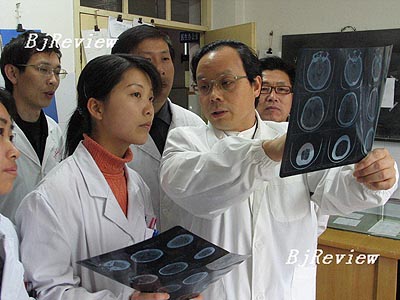|

China's public health emergency system has roughly taken shape, but remains fraught with problems, including under-trained medical staff and an inability to act quickly in the event of an epidemic, according to Vice Minister of Health Wang Longde.
Wang said that the key steps needed to ensure improved services are better training for medical personnel and emergency response education that would enable them to spot epidemics at an early stage.
The Chinese Government has drafted an outline for the development of the country's healthcare system in rural areas, which sets out an ambitious goal to provide basic medical services to the entire rural population of 800 million people. In the wake of the outbreak of severe acute respiratory syndrome (SARS) in 2003, the governments at different levels have increased its budget for rural regions.
One important measure taken by the Chinese Government was to nurture the indigenous cooperative healthcare system in rural areas by raising government subsidies.
Vice Minister of Health Chen Xiaohong said the Central Government has earmarked more than 20 billion yuan for renovations and equipment updates at clinics and hospitals across the country, to be spent over five years from 2006.
The government also initiated a nationwide campaign in 2005 to enlist about 10,000 experienced doctors from city hospitals to work in clinics and hospitals in rural areas on a temporary basis. Under the three-year program, city doctors treat patients as well as training their rural colleagues. At the end of the third year, the campaign is expected to become a permanent system.
Community hospitals
In cities, the Chinese Government has tried to streamline medical resources by playing up the role of community hospitals in treating patients for minor problems.
In countries with advanced healthcare systems, community hospitals have become the nerve center of the public healthcare system and play an important role in epidemic reporting and response. However, in China, lack of government support has for a long time turned most community hospitals into rundown, half-empty facilities. Meanwhile, larger hospitals, offering more expensive treatments and medications, have begun to burst at the seams with patients.
To make community hospitals more attractive to city residents the government is beefing up its funding for them and reducing the price of treatments; while medical experts from big hospitals are also making regular visits to community hospitals to treat outpatients and a community hospital or clinic can now transfer patients it cannot treat to a large hospital that it is connected with.
Every family in Suzhou Community, Dongcheng District, Beijing has recently been given a VIP card by their local community clinic. The holders of this card can enjoy free outpatient treatment and discounts on the price of medicines that make them about 20 percent cheaper than in large hospitals.
Since December 2006, all community hospitals and clinics in Beijing have been required to make zero profits from selling medicine, which has made community hospitals and clinics even more popular.
As part of the pilot reforms covering over 30 community clinics in Dongcheng District, including the one in Suzhou Community, these clinics are now being fully funded by the government, which pays all operational expenses and staff salaries. This has liberated doctors from economic pressure and removed incentives to prescribe unnecessary medication and treatments, since their salary no longer depends on selling medicine.
Ru Yue'en, head of the clinic in Suzhou Community, is excited by the changes. "The government has bought us equipment for routine blood tests, blood sugar tests and blood fat tests, which we had been eager to possess," Ru said.
By the end of 2007, a total of 44 community clinics in Dongcheng District will conduct the same pilot reforms that have been undertaken in the clinic in Suzhou Community. The pilot program has already led to noticeable improvements in 30 clinics, including a rise in the number of outpatient visits.
However, even these reformed clinics still face problems hindering their development, of which the most outstanding is a lack of qualified personnel. Although a stable salary provided by public finance has given community clinics an advantage in hiring, the relatively low wages they provide are unlikely to draw staff from big hospitals. The community clinic in Suzhou Community is a good example. It should have six general practitioners and three nurses, but still only has four general practitioners.
Rural challenges
In rural areas the healthcare system faces even greater challenges, according to Cai Shewen, who has conducted research on China's healthcare system for the Ministry of Finance. First and foremost, the government's investment in healthcare is largely undone by the staggering expense of administration.
| 